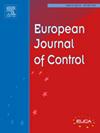基于相变速率最大化的离散LTI系统鲁棒不稳定性分析及其应用
IF 2.6
3区 计算机科学
Q2 AUTOMATION & CONTROL SYSTEMS
引用次数: 0
摘要
本文研究了离散时间传递函数的相变速率(PCR)最大化问题,并表明该问题有助于寻找最小范数稳定控制器来稳定不稳定系统——这一努力与鲁棒不稳定性分析密切相关。后者出现在非线性系统中持续振荡现象的研究和其他实际应用中。本文提出了具有唯一峰值增益频率约束的离散时间系统的PCR最大化问题,并给出了该问题的逐步解决方案。常数或一阶全通函数被证明是PCR最大化的最优解,可以被视为最坏情况下的强稳定扰动,从而为确定不稳定系统的鲁棒不稳定半径(一种有效的不稳定性度量)提供了充分条件。给出了两个实际应用程序来说明我们的结果的实用性。首先是磁悬浮系统的强稳定性,使用最小努力的数字控制器来提高能源效率。第二个涉及量化与FitzHugh-Nagumo模型中受扰动影响的神经尖峰世代相关的振荡行为的鲁棒性。本文章由计算机程序翻译,如有差异,请以英文原文为准。
Robust instability analysis of discrete-time LTI systems via phase change rate maximization and its applications
The problem of phase change rate (PCR) maximization for discrete-time transfer functions is examined and shown to facilitate the search for a minimum-norm stable controller to stabilize an unstable system — an effort that is closely related to robust instability analysis. The latter arises in the study of sustained oscillatory phenomena in nonlinear systems and other practical applications. This paper formulates the PCR maximization problem for discrete-time systems subject to constraints at the unique peak gain frequency, and provides a step-by-step solution to the problem. A constant or a first-order all-pass function are shown to be the optimal solution to PCR maximization and can be viewed as the worst-case strongly stabilizing perturbation, thereby providing a sufficient condition for determining the robust instability radius — an effective measure of instability — of an unstable system. Two real-world applications are presented to illustrate the utility of our results. The first is the strong stabilization of a magnetic levitation system using a minimum-effort digital controller for improved energy efficiency. The second involves quantifying the robustness of the oscillatory behavior associated with neural spike generations in the FitzHugh–Nagumo model subject to perturbations.
求助全文
通过发布文献求助,成功后即可免费获取论文全文。
去求助
来源期刊

European Journal of Control
工程技术-自动化与控制系统
CiteScore
5.80
自引率
5.90%
发文量
131
审稿时长
1 months
期刊介绍:
The European Control Association (EUCA) has among its objectives to promote the development of the discipline. Apart from the European Control Conferences, the European Journal of Control is the Association''s main channel for the dissemination of important contributions in the field.
The aim of the Journal is to publish high quality papers on the theory and practice of control and systems engineering.
The scope of the Journal will be wide and cover all aspects of the discipline including methodologies, techniques and applications.
Research in control and systems engineering is necessary to develop new concepts and tools which enhance our understanding and improve our ability to design and implement high performance control systems. Submitted papers should stress the practical motivations and relevance of their results.
The design and implementation of a successful control system requires the use of a range of techniques:
Modelling
Robustness Analysis
Identification
Optimization
Control Law Design
Numerical analysis
Fault Detection, and so on.
 求助内容:
求助内容: 应助结果提醒方式:
应助结果提醒方式:


